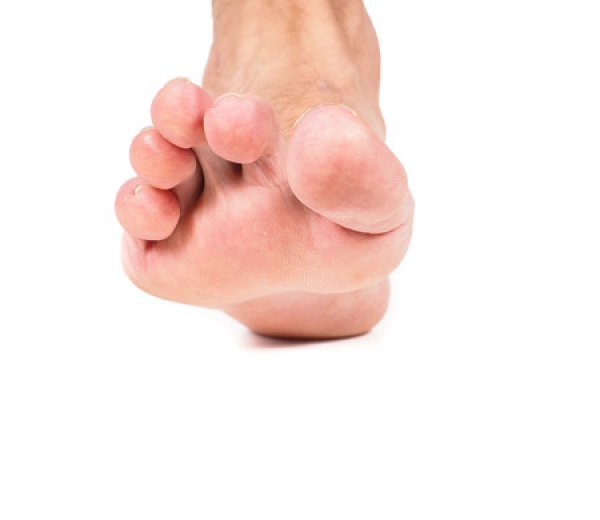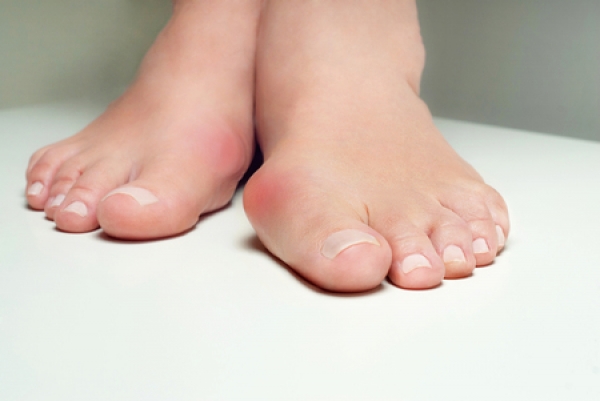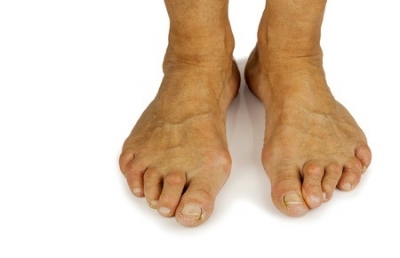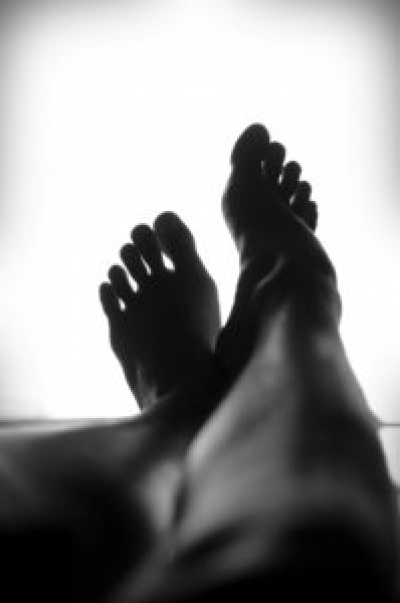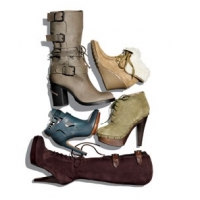Connect With Us
Blogs

Bunions (7)
At Superior Foot & Ankle Care Center, we often find that more women are making appointments at our Long Beach office in Douglas Park, CA the fall with complaints about their bunions and hammertoes. These are both deformities of the toes that can seem more painful than ever when patients switch from the open shoe styles of summer to closed toe shoes in the fall.
A bunion occurs when the big toe joint begins to move out of place and the big toe drifts toward the second toe. As the dislocation of the joint progresses, the telltale bump forms on the side of the toe. In the case of hammertoe, the second, third, or fourth toe begins to bend at the middle joint creating the hammer-like position of the toe and hence the name. Although these two conditions are different in appearance, they are both toe deformities and have several things in common.
The Shoe Factor
Bunions and hammertoes are both biomechanical problems that can be caused by an inherited tendency for the deformity, or a number of other risk factors, such as arthritis or a previous injury. Both conditions, however, can be made worse by wearing shoes that are too tight and narrow in the toe box. High-heeled shoes and boots can also exacerbate these conditions because they force feet forward and exert extra pressure on the toes.
What to Do
If you are experiencing increased discomfort from either a hammertoe or a bunion, make an appointment with our podiatrists, Dr. Victoria M. Foley or Dr. Constance Ornelas, so they can evaluate your toes and see how far the condition has progressed. The foot doctor will determine if surgery is needed to correct the problem or if you can get by at this point with conservative measures. These may include:
- Icing the toe
- Anti-inflammatory medications
- Shoe modifications or a custom orthotic
- Stretching exercises or physical therapy
Don’t wait. If you are in pain, contact us today and let us help you get relief.
At first, a bunion may appear very subtle. You may look down and notice your big toe seems to be leaning slightly toward the second toe. At Superior Foot & Ankle Care Center, we find many patients are unfamiliar with how bunions develop and therefore may not come in promptly to get them evaluated.
Know Your Risk Factors
Most often, bunions are caused by a biomechanical defect in your feet. This may be a neuromuscular problem, flat feet or overpronation. In many instances, this fault in the mechanics of your feet may be inherited. There are other factors, however, that can also increase your risk of developing a bunion, including:
- Wearing tight-fitting shoes with pointy or narrow toe boxes
- Spending long periods of time in high-heeled shoes or boots
- A previous foot injury
- Congenital defect
- Repetitive stress to the foot
- Arthritis
Seek Treatment Early
In its early stages, a bunion may not cause you any pain or discomfort. However, bunions are a progressive disorder. As time goes on, the big toe joint will move further and further out of place until it begins to cause pain when you walk. It will also become increasingly difficult to wear shoes due to the pressure exerted on the bunion by your footwear. The toe can eventually become rigid in the defective position and cause other deformities such as hammertoes to occur. It’s essential that you make an appointment at our Long Beach office so that our podiatrists, Dr. Victoria M. Foley or Dr. Constance Ornelas can examine your foot. Fortunately, there are many treatment options available which can slow the progression of the bunion and prevent foot pain and discomfort. These include:
- Altering your activities to avoid motion that exerts adverse pressure on the bunion
- Using a custom orthotic to correct the biomechanical problem and increase stability
- Exercises to increase joint mobility
- Night splints to realign the joint
If you think you have a bunion forming, don’t wait. Contact us today for an appointment by calling: (562) 420-9800.
Bunions are a condition that we at Superior Foot & Ankle Care Center treat often. A bunion is a deformity of the toe joint that most often affects the big toe. It causes the joint to move out of place and drift toward the second toe. Bunions can have a number of different causes, including:
- Neuromuscular problems
- Flat feet
- Recurring stress to the foot
- Congenital defects
- Previous injury
- Arthritis
- Ill-fitting footwear
Bunions are a progressive disorder, which means they will continue to get worse over time. Our podiatrists, Dr. Victoria Foley or Dr. Constance Omelas will start by doing a complete physical examination of your feet. While conservative measures are always preferable, if your bunion has progressed to the point where it is impeding your ability to wear shoes and walk without pain, surgery may be the best treatment option. Below are some questions to ask before scheduling bunion surgery:
What type of bunion surgery do you recommend? There are several different kinds of bunionectomies. The foot and ankle surgeon will choose the type that best addresses the structural changes that have occurred to your toe because of the deformity. Ask the podiatrist to thoroughly explain the surgical procedure and ask questions if there is anything you don’t understand.
Where will the surgery take place? Bunion surgery is usually performed on an outpatient basis under local anesthesia. It will be necessary to have someone drive you home so be sure to arrange for that before the date of the surgery.
What will the recovery be like? You will have to avoid bearing weight on the affected foot for some period of time after the surgery. Ask the foot doctor how long you will need to be out of work. In addition, you’ll want to know how much discomfort to expect post operatively. Even after you are able to bear weight and return to work, you may need to do physical therapy or use a custom orthotic. Find out what results the podiatrist expects from the surgery and what the post-surgical treatment plan will consist of.
Knowing what to expect for your bunion surgery will reduce worry and help you better prepare for the modifications to your schedule. If you have additional questions, don’t hesitate to contact our Long Beach office by calling: (562) 420-9800.
What’s the Best Way of Dealing with Bunions?
Are you prone to bunions? Maybe they develop because of the shoes you wear or maybe you’re unlucky and they run in your family. Either way, bunions aren’t something that you have to live with forever.
But before you try some drastic home remedy, here’s a quick look at bunions and how to deal with them.
What are Bunions?
The most common type of bunion is an enlargement of the inner portion of the joint at the base of the big toe. This enlargement means that your big toe’s joint is misaligned or that you have an additional bone formation. The misalignment of the big toe causes it to point outward and rotate toward the smaller toes.
A less common type of bunion is located at the joint at the bottom of the pinky toe. This type of bunion is also known as a tailor’s bunion or a bunionette.
Bunions tend to affect a greater amount of women than men. This is most likely a result of the fact that women tend to wear tighter-fitting shoes, which can increase the risk of bunion formation. It has been reported that bunions are more prevalent in people who wear closed shoes than in barefoot people.
Bunions are a progressive deformity and will increase with time, if not properly managed, although the symptoms may or may not get worse.
Causes and Symptoms
Bunions tend to develop when the pressures of bearing and shifting your weight fall unevenly on the joints and tendons in your feet. This shift in pressure causes the big toe’s joint to be unstable, eventually causing the parts of the joint to mold into a hard knob that juts out.
Some of the causes of bunions include:
- Wearing tight shoes and/or high heels
- Inherited (genetic) factors
- Trauma (sprains, fractures, and nerve injuries)
- Neuromuscular disorders (polio or Charcot-Marie-Tooth disease)
- One leg is shorter than the other
- Congenital deformities
While not all bunions cause symptoms, some of the symptoms that bunions can produce are:
- A bulging bump at the base of your big (or little) toe
- Swelling
- Redness
- Soreness
- Thickening of skin at the base of your toe
- Corns or calluses
- Persistent or intermittent pain
- Restricted toe movement
Treatment Options
There are many ways that you can help alleviate the pain of having bunions, all of which can be placed into two categories: conservative treatment and surgical options.
Conservative treatment for your bunions includes:
- Changing shoes
- Padding and taping your foot into a normal position
- Medications (acetaminophen, ibuprofen, or naproxen)
- Shoe inserts
- Maintaining a normal weight through a healthy diet
- Protect the bunion with a moleskin or gel-filled pad
- Wear a splint at night to hold the toe straight
- Use warm soaks, ice packs, whirlpool, ultrasound, and massage
Surgical options include:
- Removing the bump
- Removing part of the bone to straighten your toe
- Realigning the long bone that connects the back of your foot to your big toe
- Permanently joining the bones of your affected joint
Prevention Care
If a diagnosis of your bunion is made early on, it is possible for the bunion’s development to be slowed and, in some cases, stopped with the proper supportive gear. Avoidance of athletic activities with improper shoe fit and toe pressure can also help prevent bunion symptoms to occur.
Some simple ways to help prevent bunions are:
- Wear shoes that don’t cramp or irritate your toes
- Choose shoes with a wide toe (space between the tip of your longest toe and the end of your shoe)
- Your shoes should conform to the shape of your feet without any squeezing or pressing on any part of your foot
- Avoid pointy-toed shoes
- Avoid shoes with heels higher than 2 ¼ inches
Schedule a Consultation
Before trying any conservative methods, it is important that you get a proper diagnosis from your podiatrist to determine what your best options are for dealing with your bunions. Schedule a consultation with Dr. Vikki and Dr. Connie, so that they can help you deal with your bunions properly. With years of collective experience in her field, Dr. Vikki and Dr. Connie are your go-to team in helping you make the right decision about how to get rid of your bunion pain.
In terms of leading foot disorders, bunions certainly make the list. This common condition occurs when the big toe joint becomes misaligned and a bump forms at its base. Early on, this deformity can cause a person little to no discomfort, but in more severe cases, bunions can become very painful and interfere with normal day-to-day activities.
While advances in medical techniques have helped bunion surgery make great strides, sometimes more conservative methods can work to provide sufficient relief. These top 4 treatments won’t completely get rid of the bunions altogether, but they can work to ease the pain and prevent the situation from progressing.
Change it Up:
Often, altering your footwear choice is a great initial start for treating your bunions.This generally means avoiding irritation by wearing shoes that are roomy and wide in the toe box, rather than tight or pointed. A knowledgeable podiatrist can help you find appropriate footwear. These shoes not only will offer a better orthopedic fit, but will be better designed or made of materials like soft leather, as to prevent inflaming the bunion.
Protect it:
Moleskin pads and gel guards can work as a type of shield for the bunion, protecting it from agitation and friction. In addition to their pain-relieving qualities, these items can help to prevent the development of corns, calluses and hammertoes, which often can be a subsequent result of the condition.
Support it:
Inserts and orthotics are additional conservative treatments that can provide valuable bunion relief. By redistributing weight, they lessen the pressure that’s placed on the misaligned toe joint. There are several over the counter options available in stores, but for a more customized insert to fit your foot, your podiatrist may prescribe a specific orthotic.
Ice it:
If your bunion is agitated or inflamed, ice can alleviate the pain. Applying ice packs several times a day, for roughly 20 minutes, will work to reduce swelling and discomfort.
Discover the Best Option for Your Bunion
At times, home remedies and conservative treatments can be great avenues for bunion relief. However, as each case is unique, getting the most appropriate care is done after meeting with a podiatrist. At Superior Foot & Ankle Care Center, we view surgery as the last resort, but we also understand the benefits it can offer certain patients. Now that these procedures are performed on an outpatient basis and require less downtime, bunion surgery is easier and far more convenient for patients. Whatever your individual case may be, we will carefully determine the best treatment plan to get your feet back on a healthy track. So, if you would like to discover the best option for your bunion, please schedule an appointment at our Long Beach office today.
Toenail fungus also known as onychomycosis, is a common occurrence among adults. Many people get a nail fungus infection when using public gyms, shower stalls, swimming pools, or even unsanitary nail salons. Nail fungus is an infection that begins as a white or yellow spot under your nail. As the infection continues to grow it can lead to nail discoloration and your nail can begin to crumble. Prevent nail fungus by taking the following precautions:
Visiting a Nail Salon
This is one of the easiest ways to contract a nail fungus infection. There are so many people going in and out of theses shops that it is hard to tell whether the staff is taking proper precautions and sterilizing their tools properly. Prevent toenail fungus infection by taking your own pedicure kit with you when getting a pedicure at a salon protect your feet.
Keep Toenails Dry
Toenail fungus thrives in warm and moist environments making it a bit more difficult to get rid of. Be sure to change your socks frequently, especially after any sports or physical activities. Sprinkle antibacterial foot powder on your toes and shoes to soak up some of the moisture.
Prevent Fungus from Spreading
If you see white or yellowish spots beginning to form, soak your nails to prevent infection. Soak your feet in a mixture of 1 ounce of vinegar and 5 ounces of water, this solution can kill the bacteria that’s forming.
Cutting Nail Incorrectly
It’s important to know what the appropriate length is for toenails and how to cut them properly. Your toenail should line the tip of your toe and should be cut straight across and not round. Cutting them any lower than your normal length can leave your nail beds unprotected leading to a toenail fungus or an ingrown toenail.
Removing toenail fungus is difficult, which is why you should always take the proper precautions to prevent it. If your toenail is completely discolored and unattractive, contact your foot doctor in Long Beach to schedule an appointment to learn about your treatment options.
Many people who suffer from bunions tell their podiatrist that cold weather makes their bunion hurt worst. There is no evidence that cold weather is what is causing the increase in pain. Rather, foot doctors believe that it is the change in the type of foot wear people use during cold weather that causes the increase in pain.
Most patients seeking bunion treatment are women. During fall and winter, women stop wearing sandals and open-toed shoe styles and start wearing boots and closed-toed shoes. This big change in their footwear can cause irritation to the bunion.
Foot doctor Long Beach recognizes that there is an increase in bunion treatment during cold weather because patients wear shoes that aggravate the joint bursa. Once the joint bursa is aggravated, it becomes red and inflamed, causing the bunion to ache.
Bunions do not go away over time or on their own. Once a bunion forms, it is best to seek bunion treatment from a foot doctor Long Beach. People with bunions will have periods where the bunion does not hurt but over time, the bunion can become irritated and grow. Bunion treatment can be conservative and painless but it is up to the patient to seek treatment. Bunion surgery Long Beach is usually the final answer in safe, permanent bunion treatment.
Women love shoes and during the colder seasons, they seek out stylish boots. Unfortunately, those boots can cause more traumas to the feet. Bunions form on the big toe joint which can be pushed on by tight, ill-fitting, or leather boots. The problems and pain are increased when the boots have a heel. The pain during fall and winter can make some women wish they didn’t have to wear shoes at all.
The pain patients feel from winter style shoes does not just cause more pain now but it can cause bigger bunions over time. Harvard Health Publications urges women to wear the right kind of shoes. If you have a bunion, be mindful of wearing wide shoes with a flexible sole. Heels and boots will not accommodate the bunion and can make mattes much worse.
The bunion surgeon Long Beach patients trust most can discuss your bunion treatment options to begin your road to a bunion pain-free life.
